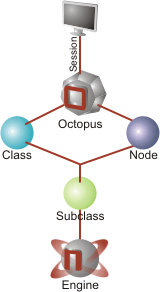The Octopus system has the following components (illustrated in Figure 3):

Figure 3: Octopus Components
The Octopus utility is the central component of the system. It controls the operation of the database server engines (OctoEng�s), manages client connections to the OctoEng�s, schedules the execution of queries, and compiles statistical information about the operation of the system.
Nodes
A Node is a computer that is set up as the host for one or more OctoEng instances running under Octopus. The central Node of the system is the main Octopus server. If remote Nodes are implemented, an Octopus Agent must be installed on each, enabling Octopus to control the operation of the remote OctoEng�s.
Classes and Subclasses
An Octopus Class is a group of OctoEng�s that share the same configuration parameters. Each Class provides a specific level of database services. The number, names, and hierarchical ordering of the Octopus Classes are specified with the Classes parameter in the Octopus section(s) of the SAND CDBMS configuration file. At least one Class must be defined for the Octopus system.The actual execution parameters for the OctoEng�s in a given Class are set in the Subclass sections of the SAND CDBMS configuration file. A Subclass represents the implementation of a Class on a specific Node (see above).
Engines (OctoEng's)
Octopus Engines (OctoEng�s) are the actual database server engines operating under the control of Octopus. Parameters relating to the operation of individual OctoEng�s (for example, port number) are set automatically by Octopus.
Sessions
An Octopus Session is an individual client connection to the main Octopus server. All users specify the same connection name (defining the host name and port number for the connection) when connecting to Octopus; connections to the individual OctoEng�s are handled internally and transparently.